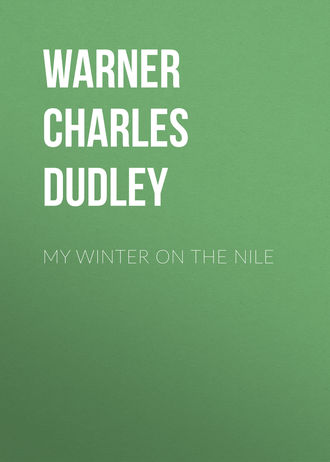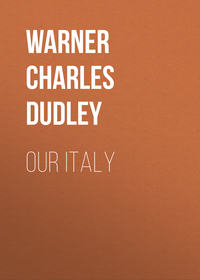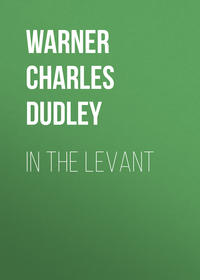 полная версия
полная версияMy Winter on the Nile
But for this Conscience, I think nothing would be so sweet as the coming of an eastern morning. I fancy that the cool wind stirring in the palms is from the pure desert. It may be that these birds, so melodiously singing in the garden, are the small green birds who eat the fruits and drink the waters of Paradise, and in whose crops the souls of martyrs abide until Judgment. As I lie quite still, I hear the call of a muezzin from a minaret not far off, the voice now full and clear and now faint, as he walks around the tower to send his entreaty over the dark roofs of the city. I am not disturbed by this early call to the unconverted, for this is not my religion. With the clamor of morning church bells in Italy it is different; for to one born in New England, Conscience is in the bells.
Sometimes at midnight I am dimly conscious of the first call to prayer, which begins solemnly:
“Prayer is better than sleep.”
But the night calls are not obligatory, and I do not fully wake. The calls during the night are long chants, that of the daytime is much shorter. Mr. Lane renders it thus:
“God is most Great” (four times repeated). “I testify that there is no deity but God” (twice). “I testify that Mohammed is God’s Apostle” (twice). “Come to prayer” (twice). “Come to security” (twice). “God is most Great” (twice). “There is no deity but God.”
The muezzin whom I hear when the first faint light appears in the east, has a most sonorous and sweet tenor voice, and his chant is exceedingly melodious. In the perfect hush of that hour his voice fills all the air, and might well be mistaken for a sweet entreaty out of heaven. This call is a long one, and is in fact a confession and proclamation as well as a call to prayer. It begins as follows:
“[I extol] the perfection of God, the Existing forever and ever” (three times): “the perfection of God, the Desired, the Existing, the Single, the Supreme: the perfection of God, the One, the Sole: the perfection of Him who taketh to Himself, in his great dominion, neither female companion nor male partner, nor any like unto Him, nor any that is disobedient, nor any deputy, nor any equal, nor any offspring. His perfection [be extolled]: and exalted be His name. He is a Deity who knew what hath been before it was, and called into existence what hath been; and He is now existing, as He was [at the first]. His perfection [be extolled]: and exalted be His name.”
And it ends: “O God, bless and save and still beatify the beatified Prophet, our lord Mohammed. And may God, whose name be blessed and exalted, be well pleased with thee, O our lord El-Hassan, and with thee, O our lord El-Hoseyn, and with thee, O Aboo-Farrâg, O Sheykh of the Arabs, and with all the favorites [’.he welees’. of God. Amen.”
The mosques of Cairo are more numerous than the churches in Rome; there are about four hundred, many of them in ruins, but nearly all in daily use. The old ones are the more interesting architecturally, but all have a certain attraction. They are always open, they are cool quiet retreats out of the glare of the sun and the noise of the street; they are democratic and as hospitable to the beggar in rags as to the pasha in silk; they offer water for the dusty feet of the pilgrim and a clean mat on which to kneel; and in their hushed walls, with no images to distract the mind and no ritual to rely on, the devout worshipper may feel the presence of the Unseen. At all hours you will see men praying there or reading the Koran, unconscious of any observers. Women I have seen in there occasionally, but rarely, at prayer; still it is not uncommon to see a group of poor women resting in a quiet corner, perhaps sewing or talking in low voices. The outward steps and open courts are refuges for the poor, the friendless, the lazy, and the tired. Especially the old and decaying mosques, do the poor frequent. There about the fountains, the children play, and under the stately colonnades the men sleep and the women knit and sew. These houses of God are for the weary as well as for the pious or the repentant.
The mosques are all much alike. We enter by a few or by a flight of steps from the street into a large paved court, open to the sky, and surrounded by colonnades. There is a fountain in the center, a round or octagonal structure of carved stone, usually with a fanciful wooden roof; from faucets in the exterior, water runs into a surrounding stone basin about which the worshippers crouch to perform the ablutions before prayer. At one side of the court is the entrance to the mosque, covered by a curtain. Pushing this aside you are in a spacious room lighted from above, perhaps with a dome, the roof supported by columns rising to elegant arches. You will notice also the peculiar Arabic bracketing-work, called by architects “pendentive,” fitting the angles and the transitions from the corners below to the dome. In decaying mosques, where the plaster has fallen, revealing the round stick frame-work of this bracketing, the perishable character of Saracenic ornament is apparent.
The walls are plain, with the exception of gilded texts from the Koran. Above, on strings extending across the room are little lamps, and very often hundreds of ostrich eggs are suspended. These eggs are almost always seen in Coptic and often in Greek churches. What they signify I do not know, unless the ostrich, which can digest old iron, is a symbol of the credulity that can swallow any tradition. Perhaps her eggs represent the great “cosmic egg” which modern philosophers are trying to teach (if we may be allowed the expression) their grandmothers to suck.
The stone pavement is covered with matting and perhaps with costly rugs from Persia, Smyrna, and Tunis. The end towards Mecca is raised a foot or so; in it is the prayer niche, towards which all worshippers turn, and near that is the high pulpit with its narrow steps in front; a pulpit of marble carved, or of wood cut in bewildering arabesque, and inlaid with pearl.
The oldest mosque in Cairo is Ahmed ebn e’ Tooloon, built in 879 A.D., and on the spot where, according to a tradition (of how high authority I do not know), Abraham was prevented from offering up his son by the appearance of a ram. The modern name of this hill is, indeed, Kalat-el-Kebsh, the Citadel of the Ram. I suppose the tradition is as well based as is the belief of Moslems that it was Ishmael and not Isaac whose life was spared. The center of this mosque is an open court, surrounded by rows of fine columns, five deep on the East side; and what gives it great interest is the fact that the columns all support pointed arches, and exceedingly graceful ones, with a slight curve of the horse-shoe at the base. These arches were constructed about three centuries before the introduction of the pointed arch into Europe; their adoption in Europe was probably one of the results of the Crusades.
In this same court I saw an old Nebk tree, which grows on the spot where the ark of Noah is said to have rested after its voyage. This goes to show, if it goes to show anything, that the Flood was “general” enough to reach Egypt.
The mosque of Sultan Hassan, notwithstanding its ruined and shabby condition, is the finest specimen of pure Arabic architecture in the city; and its lofty and ornamented porch is, I think, as fine as anything of its kind in the world. One may profitably spend hours in the study of its exquisite details. I often found myself in front of it, wondering at the poetic invention and sensitiveness to the beautiful in form, which enabled the builders to reach the same effects that their Gothic successors only produced by the aid of images and suggestions drawn from every department of nature.
We ascend the high steps, pass through some dilapidated parts of the building, which are inhabited, and come to the threshold. Here the Moslem removes his shoes, or street-slippers, and carries them in his hand. Over this sill we may not step, shod as we are. An attendant is ready, however, with big slippers which go on over our shoes. Eager, bright little boys and girls put them on for us, and then attend us in the mosque, keeping a close watch that the slippers are not shuffled off. When one does get off, leaving the unholy shoe to touch the ground, they affect a sort of horror and readjust it with a laugh. Even the children are beginning to feel the general relaxation of bigotry. To-day the heels of my shoes actually touch the floor at every step, a transgression which the little girl who is leading me by the hand points out with a sly shake of the head. The attention of this pretty little girl looks like affection, but I know by sad experience that it means “backsheesh.” It is depressing to think that her natural, sweet, coquettish ways mean only that. She is fierce if any other girl seeks to do me the least favor, and will not permit my own devotion to her to wander.
The mosque of Sultan Hassan was built in the fourteenth century, and differs from most others. Its great, open court has a square recess on each side, over which is a noble arch; the east one is very spacious, and is the place of prayer. Behind this, in an attached building, is the tomb of Hassan; lights are always burning over it, and on it lies a large copy of the Koran.
When we enter, there are only a few at their devotions, though there are several groups enjoying the serenity of the court; picturesque groups, all color and rags! In a far corner an old man is saying his prayers and near him a negro, perhaps a slave, also prostrates himself. At the fountain are three or four men preparing for devotion; and indeed the prayers begin with the washing. The ablution is not a mere form with these soiled laborers—though it does seem a hopeless task for men of the color of these to scrub themselves. They bathe the head, neck, breast, hands and arms, legs and feet; in fact, they take what might be called a fair bath in any other country. In our sight this is simply a wholesome “wash”; to them it is both cleanliness and religion, as we know, for Mr. Lane has taught us what that brown man in the blue gown is saying. It may help us to understand his acts if we transcribe a few of his ejaculations.
When he washes his face, he says:—“O God whiten my face with thy light, on the day when thou shalt whiten the faces of thy favorites; and do not blacken my face, on the day when Thou shalt blacken the faces of thine enemies.” Washing his right arm, he entreats:—“O God, give me my book in my right hand; and reckon with me with an easy reckoning.” Passing his wetted hand over his head under his raised turban, he says:—“O God, cover me with thy mercy, and pour down thy blessing upon me; and shade me under the shadow of thy canopy, on the day when there shall be no shade but its shade.”
One of the most striking entreaties is the prayer upon washing the right foot:—“O God, make firm my feet upon the Sirat, on the day when feet shall slip upon it.”
“Es Sirât” is the bridge, which extends over the midst of Hell, finer than a hair and sharper than the edge of a sword, over which all must pass, and from which the wicked shall fall into Hell.
In these mosques order and stillness always reign, and the devotions are conducted with the utmost propriety, whether there are single worshippers, or whether the mosque is filled with lines of gowned and turbaned figures prostrating themselves and bowing with one consent. But, much stress as the Moslems lay upon prayer, they say that they do not expect to reach Paradise by that, or by any merit of their own, but only by faith and forgiveness. This is expressed frequently both in prayers and in the sermons on Friday. A sermon by an Imam of a Cairo mosque contains these implorings:—“O God! unloose the captivity of the captives, and annul the debts of the debtors; and make this town to be safe and secure, and blessed with wealth and plenty, and all the towns of the Moslems, O Lord of the beings of the whole earth. And decree safety and health to us and to all travelers, and pilgrims, and warriors, and wanderers, upon thy earth, and upon thy sea, such as are Moslems, O Lord of the beings of the whole world. O Lord, we have acted unjustly towards our own souls, and if Thou do not forgive us and be merciful unto us, we shall surely be of those who perish. I beg of God, the Great, that He may forgive me and you, and all the people of Mohammed, the servants of God.”
CHAPTER VIII.—THE PYRAMIDS
THE ancient Egyptians of the Upper Country excavated sepulchres for their great dead in the solid rocks of the mountain; the dwellers in the lower country built a mountain of stone in which to hide the royal mummy. In the necropolis at Thebes there are the vast rock-tombs of the kings; at Sakkara and Geezeh stand the Pyramids. On the upper Nile isolated rocks and mountains cut the sky in pyramidal forms; on the lower Nile the mountain ranges run level along the horizon, and the constructed pyramids relieve the horizontal lines which are otherwise unbroken except by the palms.
The rock-tombs were walled up and their entrances concealed as much as possible, by a natural arrangement of masses of rock; the pyramids were completely encased and the openings perfectly masked. False passages, leading through gorgeously carved and decorated halls and chambers to an empty pit or a blind wall, were hewn in the rock-tombs, simply to mislead the violator of the repose of the dead as to the position of the mummy. The entrance to the pyramids is placed away from the center, and misleading passages run from it, conducting the explorer away from the royal sarcophagus. Rock-tomb and pyramid were for the same purpose, the eternal security of the mummy.
That purpose has failed; the burial-place was on too grand a scale, its contents were too tempting. There is no security for any one after death but obscurity; to preserve one’s body is to lose it. The bones must be consumed if they would be safe, or else the owner of them must be a patriot and gain a forgotten grave. There is nothing that men so enjoy as digging up the bones of their ancestors. It is doubtful if even the Egyptian plunderers left long undisturbed the great tombs which contained so much treasure; and certainly the Persians, the Greeks, the Romans, the Saracens, left comparatively little for the scientific grave-robbers of our excellent age. They did, however, leave the tombs, the sarcophagi, most of the sculptures, and a fair share of the preserved dead.
But time made a pretty clean sweep of the mummy and nearly all his personal and real property. The best sculptures of his tomb might legally be considered in the nature of improvements attaching themselves to the realty, but our scientists have hacked them off and carried them away as if they were personal estate. We call the Arabs thieves and ghouls who prowl in the the tombs in search of valuables. But motive is everything; digging up the dead and taking his property, tomb and all, in the name of learning and investigation is respectable and commendable. It comes to the same thing for the mummy, however, this being turned out of house and home in his old age. The deed has its comic aspect, and it seems to me that if a mummy has any humor left in his dried body, he must smile to see what a ludicrous failure were his costly efforts at concealment and repose. For there is a point where frustration of plans may be so sweeping as to be amusing; just as the mummy himself is so ghastly that his aspect is almost funny.
Nothing more impresses the mind with the antiquity of Egypt than its vast cemeteries, into which the harvests of the dead have been gathered for so many thousands of years. Of old Memphis, indeed, nothing remains except its necropolis, whose monuments have outlasted the palaces and temples that were the wonder of the world. The magnificence of the city can be estimated by the extent of its burial-ground.
On the west side of the Nile, opposite Cairo, and extending south along the edge of the desert, is a nearly continuous necropolis for fifteen miles. It is marked at intervals by pyramids. At Geezeh are three large and several small ones; at Abooseer are four; at Sakkara are eleven; at Dashoor are four. These all belonged to the necropolis of Memphis. At Geezeh is the largest, that of Cheops or Shoofoo, the third king of the fourth dynasty, reigning at Memphis about 4235 B.C., according to the chronology of Mariette Bey, which every new discovery helps to establish as the most probably correct. This pyramid was about four hundred and eighty feet high, and the length of a side of its base was about seven hundred and sixty-four feet; it is now four hundred and fifty feet high and its base line is seven hundred and forty-six feet. It is big enough yet for any practical purpose. The old pyramid at Sakkara is believed to have been built by Ouenephes, the fourth king of the first dynasty, and to be the oldest monument in the world. Like the mounds of the Chaldeans, it is built in degrees or stages, of which there are five. Degraded now and buried at the base in its own rubbish, it rises only about one hundred and ninety feet above the ground.
It is a drive of two hours from Cairo to the Pyramids of Geezeh, over a very good road; and we are advised to go by carriage. Hadji is on the seat with the driver, keeping his single twinkling eye active in the service of the howadji. The driver is a polished Nubian, with a white turban and a white gown; feet and legs go bare. You wouldn’t call it a stylish turnout for the Bois, but it would be all right if we had a gorgeous sais to attract attention from ourselves.
We drive through the wide and dusty streets of the new quarter. The barrack-like palace, on the left of abroad place, is the one in which the Khedive is staying just now, though he may be in another one to-night. The streets are the same animated theater-like scenes of vivid color and picturesque costume and indolent waiting on Providence to which we thought we should never become accustomed, but which are already beginning to lose their novelty. The fellaheen are coming in to market, trudging along behind donkeys and camels loaded with vegetables or freshly cut grass and beans for fodder. Squads of soldiers in white uniform pass; bugle notes are heard from Kasr e’ Neel, a barrack of troops on the river. Here, as in Europe, the great business most seriously pursued is the drilling of men to stand straight, handle arms, roll their eyes, march with a thousand legs moving as one, and shoot on sight other human beings who have learned the same tricks. God help us, it is a pitiful thing for civilized people.
The banks of the Nile here above Boolak are high and steep. We cross the river on a fine bridge of iron, and drive over the level plain, opposite, on a raised and winding embankment. This is planted on each side with lebbekh and sycamore trees. Part of the way the trees are large and the shade ample; the roots going down into moist ground. Much of the way the trees are small and kept alive by constant watering. On the right, by a noble avenue are approached the gardens and the palace of Gezeereh. We pass by the new summer palace of Geezeh. Other large ones are in process of construction. If the viceroy is measured for a new suit of clothes as often as he orders a new palace, his tailors must be kept busy. Through the trees we see green fields, intersected with ditches, wheat, barley, and beans, the latter broad-sown and growing two to three feet high; here and there are lines of palms, clumps of acacias; peasants are at work or asleep in the shade; there are trains of camels, and men plowing with cows or buffaloes. Leaving the squalid huts that are the remains of once beautiful Geezeh, the embankment strides straight across the level country.
And there before us, on a rocky platform a hundred feet higher than the meadows, are the pyramids, cutting the stainless blue of the sky with their sharp lines. They master the eye when we are an hour away, and as we approach they seem to recede, neither growing larger nor smaller, but simply withdrawing with a grand reserve.
I suppose there are more “emotions” afloat about the pyramids than concerning any other artificial’ objects. There are enough. It becomes constantly more and more difficult for the ordinary traveler to rise to the height of these accumulated emotions, and it is entirely impossible to say how much the excitement one experiences on drawing near them results from reading and association, and how much is due to these simple forms in such desolate surroundings. But there they stand, enduring standards, and every visitor seems inclined to measure his own height by their vastness, in telling what impression they produce upon him. They have been treated sentimentally, off-handedly, mathematically, solemnly, historically, humorously. They yield to no sort of treatment. They are nothing but piles of stone, and shabby piles at that, and they stand there to astonish people. Mr. Bayard Taylor is entirely right when he says that the pyramids are and will remain unchanged and unapproachably impressive however modern life may surge about them, and though a city should creep about their bases.
Perhaps they do not appear so gigantic when the visitor is close to them as he thought they would from their mass at a distance. But if he stands at the base of the great pyramid, and casts his eye along the steps of its enormous side and up the dizzy height where the summit seems to pierce the solid blue, he will not complain of want of size. And if he walks around one, and walks from one to another wading in the loose sand and under a midday sun, his respect for the pyramids will increase every moment.
Long before we reach the ascent of the platform we are met by Arab boys and men, sellers of antiquities, and most persistent beggars. The antiquities are images of all sorts, of gods, beasts, and birds, in pottery or in bronze, articles from tombs, bits of mummy-cloth, beads and scarabæi, and Roman copper coins; all of them at least five thousand years old in appearance.
Our carriage is stuck in the sand, and we walk a quarter of a mile up the platform, attended by a rabble of coaxing, imploring, importunate, half-clad Bedaween. “Look a here, you take dis; dis ver much old, he from mummy; see here, I get him in tomb; one shillin; in Cairo you get him one pound; ver sheap. You no like? No anteeka, no money. How much?”
“One penny.”
“Ah,” ironically, “ket’-ther khâyrak (much obliged). You take him sixpence. Howadji, say, me guide, you want go top pyramid, go inside, go Sphinkee, allée tomba?”
Surrounded by an increasing swarm of guides and antiquity-hawkers, and beset with offers, entreaties, and opportunities, we come face to face with the great pyramid. The ground in front of it is piled high with its debris. Upon these rocks, in picturesque attitudes, some in the shade and some in the sun, others of the tribe are waiting the arrival of pyramid climbers; in the intense light their cotton garments and turbans are like white paint, brilliant in the sun, ashy in the shadow. All the shadows are sharp and deep. A dark man leaning on his spear at the corner of the pyramid makes a picture. At a kiosk near by carriages are standing and visitors are taking their lunch. But men, carriages, kiosk, are dwarfed in this great presence. It is, as I said, a shabby pile of stone, and its beauty is only that of mathematical angles; but then it is so big, it casts such a shadow; we all beside it are like the animated lines and dots which represent human beings in the etchings of Callot.
To be rid of importunities we send for the sheykh of the pyramid tribe. The Bedaween living here have a sort of ownership of these monuments, and very good property they are. The tribe supports itself mainly by tolls levied upon visitors. The sheykh assigns guides and climbers, and receives the pay for their services. This money is divided among the families; but what individuals get as backsheesh or by the sale of antiquities, they keep. They live near by, in huts scarcely distinguishable from the rocks, many of them in vacant tombs, and some have shanties on the borders of the green land. Most of them have the appearance of wretched poverty, and villainous faces abound. But handsome, intelligent faces and finely developed forms are not rare, either.
The Sheykh, venerable as Jacob, respectable as a New England deacon, suave and polite as he traditionally should be, wears a scarf of camel’s hair and a bright yellow and black kuffia, put on like a hood, fastened about the head by a cord and falling over the shoulders. He apportioned his guides to take us up the pyramid and to accompany us inside. I had already sent for a guide who had been recommended to me in the city, and I found Ali Gobree the frank, manly, intelligent, quiet man I had expected, handsome also, and honesty and sincerity beaming from his countenance. How well-bred he was, and how well he spoke English. Two other men were given me; for the established order is that two shall pull and one shall push the visitor up. And it is easier to submit to the regulation than to attempt to go alone and be followed by an importunate crowd.







